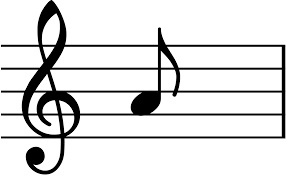|
|
| |
|
|
| |
|
|
|
|
| |
 |
| The note A or La. |
Musical Symbols
Musical symbols are marks and symbols in musical
notation that indicate various aspects of how a piece of
music is to be performed. There are symbols to
communicate information about many musical elements,
including pitch, duration, dynamics, or articulation of
musical notes; tempo, metre, form (e.g., whether
sections are repeated), and details about specific
playing techniques (e.g., which fingers, keys, or pedals
are to be used, whether a string instrument notes are
bowed or plucked, or whether the bow of a string
instrument should move up or down). |
|
Lines
Staff
The five-line staff (often "stave" in British usage) is used
to indicate pitch. Each line or space indicates the pitch
belonging to a note with a letter name: A, B, C, D, E, F, G.
Moving vertically upwards, the letter names proceed
alphabetically with the alternating lines and spaces, and
represent ascending pitches. The A-G pattern repeats—the
note above "G" is another "A". A clef determines which
specific pitches are assigned to the lines and spaces. |
|
Clefs
A clef defines the pitch range, or tessitura, of the
staff on which it is placed. A clef is usually the
leftmost symbol on a staff although a different clef may
appear elsewhere to indicate a change in register.
Historically, clefs could be placed on any line on a
staff (or even on a space), but modern notation almost
exclusively uses treble, bass, alto, and tenor clef. |
G clef (Treble
clef)
The spiral of a G clef shows where the G above middle C is
located on the staff. A G clef with the spiral on the second
line of the staff is called treble clef. The treble clef is
the most commonly encountered clef in modern notation. |
|
Rhythmic values
of notes and rests
Musical note and rest values are determined in reference
to the length of a whole note. The other notes are named
(in American usage) in comparison—a half note is half
the length of a whole note, a quarter note is one
quarter the length, etc.
The basic and commonly used musical symbols listed from
top to bottom
Whole note
Half note
Quarter note
Eighth note |
|
|
|
Click the Wikipedia link for a lot more information. |
|
|
 Wikipedia: List of musical symbols Wikipedia: List of musical symbols |
|
|
|
|
|
|
|
|
|
|
|
|
|
|
|
|
Search Fun Easy English |
|
|
|
|
|
|
|
|
|
|
|
|
|
|
|
About
Contact
Copyright
Resources
Site Map |